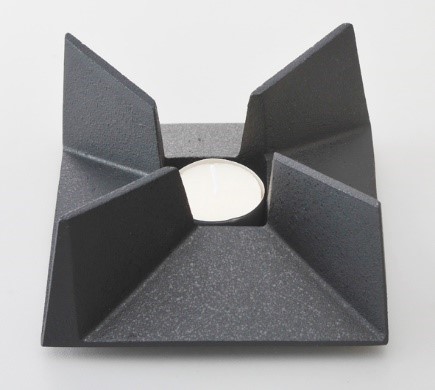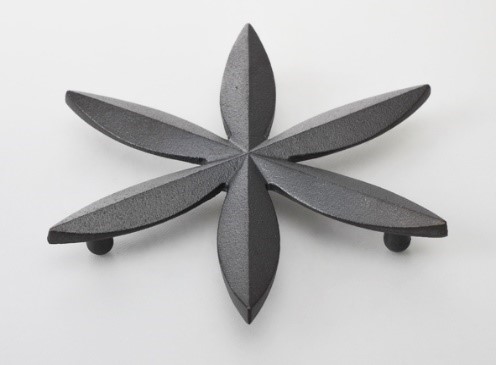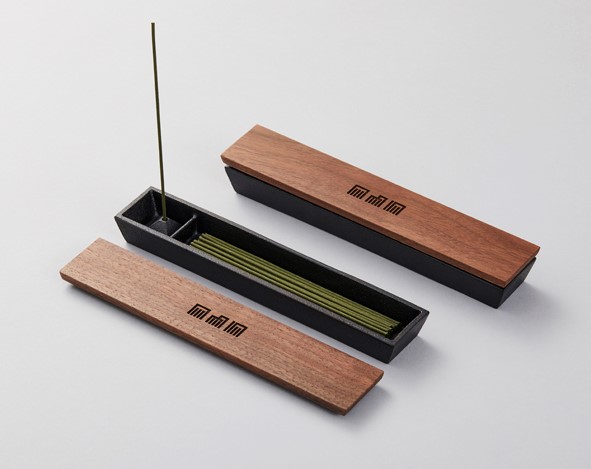EPISODE OF FAUNDATION / FOUNDER'S THOUGHT
Chushin Kobo studio was established in 1997 for the purpose of manufacturing and selling products designed by myself, Hisanori Masuda.The studio proposes to incorporate the traditional beauty of castings that has been passed down for centuries in Japan into today's lifestyle.I studied at Musashino Art University under Professor Mosuke Yoshitake and worked as an assistant to Professor Yoshitake after graduation.Over this period of time, I learned about the important role of design from him.I then moved to Yamagata Prefecture and over the next 20 years learned the traditional techniques for making kettles used in the tea ceremony ("chagama" in Japanese) from artisans at the site.Based on the teachings from Professor Yoshitake and these artisans, I established my own brand, blending traditional techniques with my own design to pursue the potential of Yamagata Imono (Iron Casting).
CRAFTMAN'S THOUGHT, COMMITMENT / RELATIONSHIP WITH THE COMMUNITY
To pass on traditional crafts handed down in the region to the next generation, it is important to manufacture items that are useful in today's life.Lifestyles are constantly changing with the times so it is necessary to preserve and develop the inherited techniques and pass them on to the next generation in response to these changes.Traditional crafts are not conservative and maintain innovative elements in any period.New attempts will lead to the succession of traditional techniques.Nine-hundred and fifty years ago, it was found that the sand from the Mamigasaki River beach and the clay in the area near Chitose Park are suitable for making molds, which became the starting point for Yamagata Iron Casting.Domachi town is the birthplace of Yamagata Iron Casting.It is not only an industry but also an important regional culture.Preserving the landscape of the town will lead to preserving Yamagata Iron Casting.
The product is designed to value usability and moderate the iron cast's image of hardness by using wood in the handle and knob. The bottom is shaped flat to increase thermal conductivity, and secures the appropriate base area to use with electromagnetic cookers. For finishing, it is biscuit-fired at 800 degrees Celsius to cover with oxide film to prevent rusting. Then, a baking finish with Japanese lacquer is applied to the oxide film-covered surface. When boiling water with an iron kettle finished in this manner, the water will become smooth, less smelly and taste good. As iron is leeched into the boiled water, simply drinking water boiled in the teapot will provide the necessary daily amount. The handle and knob are replaceable.
The product is designed to value usability and moderate the iron cast's image of hardness by using wood in the handle and knob. The bottom is shaped flat to increase thermal conductivity, and secures the appropriate base area to use with electromagnetic cookers. For finishing, it is biscuit-fired at 800 degrees Celsius to cover with oxide film to prevent rusting. Then, a baking finish with Japanese lacquer is applied to the oxide film-covered surface. When boiling water with an iron kettle finished in this manner, the water will become smooth, less smelly and taste good. As iron is leeched into the boiled water, simply drinking water boiled in the teapot will provide the necessary daily amount. The handle and knob are replaceable.
This modern teapot is designed to meet today's lifestyle and is made using techniques for making kettles used in the tea ceremony, which is part of typical Japanese culture. The outside of the teapot employs the traditional "sunahada" textured surface, the inside is enameled to keep it rust-free, and a tea strainer made of stainless steel is provided. You can choose a handle made of iron, brass or stainless steel. Iron castings have heat retaining properties, so this product keeps tea hot longer.
This modern teapot is designed to meet today's lifestyle and is made using techniques for making kettles used in the tea ceremony, which is part of typical Japanese culture. The outside of the teapot employs the traditional "sunahada" textured surface, the inside is enameled to keep it rust-free, and a tea strainer made of stainless steel is provided. You can choose a handle made of iron, brass or stainless steel. Iron castings have heat retaining properties, so this product keeps tea hot longer.
This modern teapot is designed to meet today's lifestyle and is made using techniques for making kettles used in the tea ceremony, which is part of typical Japanese culture. The outside of the teapot employs the traditional "sunahada" textured surface, the inside is enameled to keep it rust-free, and a tea strainer made of stainless steel is provided. You can choose a handle made of iron, brass or stainless steel. Iron castings have heat retaining properties, so this product keeps tea hot longer.
This modern teapot is designed to meet today's lifestyle and is made using techniques for making kettles used in the tea ceremony, which is part of typical Japanese culture. The outside of the teapot employs the traditional "sunahada" textured surface, the inside is enameled to keep it rust-free, and a tea strainer made of stainless steel is provided. You can choose a handle made of iron, brass or stainless steel. Iron castings have heat retaining properties, so this product keeps tea hot longer.

-
Brand name
Chushin Kobo
-
Product name
HS-55L / Warmer Madoka L
-
Generic name
Warmer
-
Materials
Cast iron
-
Person in Charge
Chushin Kobo
-
Production area
Yamagata Yamagata Japan
-
Size
140x140x70mm
-
Weight
1,000g
-
Domestic retail price
JPY5,300 (excluding tax)
In addition to heat-retaining properties, the light of a candle used for this warmer illuminates the table and brightens up the atmosphere. Placing an iron or other type of kettle on the warmer and having hot tea will allow you to enjoy a relaxing time. The warmer is not used for boiling water but for keeping boiled water warm.

-
Brand name
Chushin Kobo
-
Product name
HS-54L / Warmer Igeta L
-
Generic name
Warmer
-
Materials
Cast iron
-
Person in Charge
Chushin Kobo
-
Production area
Yamagata Yamagata Japan
-
Size
130x130x70mm
-
Weight
1.200g
-
Domestic retail price
JPY5,300 (excluding tax)
In addition to heat-retaining properties, the light of a candle used for this warmer illuminates the table and brightens up the atmosphere. Placing an iron or other type of kettle on the warmer and having hot tea will allow you to enjoy a relaxing time. The warmer is not used for boiling water but for keeping boiled water warm.
The pot stand is a very useful tool. It is of course used as a stand on which to place a pot or a kettle on a table, but can also be used as a table decoration. This casting tea stand placed on a table will make the atmosphere around the dining table gorgeous. Moreover, the pot stand can be hung on a kitchen wall as an interior accessory.
The pot stand is a very useful tool. It is of course used as a stand on which to place a pot or a kettle on a table, but can also be used as a table decoration. This casting tea stand placed on a table will make the atmosphere around the dining table gorgeous. Moreover, the pot stand can be hung on a kitchen wall as an interior accessory.

-
Brand name
Chushin Kobo
-
Product name
HS-98 / Pot stand Itsuwa
-
Generic name
Pot stand
-
Materials
Cast iron
-
Person in Charge
Chushin Kobo
-
Production area
Yamagata Yamagata Japan
-
Size
170x165x20mm
-
Weight
500g
-
Domestic retail price
JPY5,000 (excluding tax)
The pot stand is a very useful tool. It is of course used as a stand on which to place a pot or a kettle on a table, but can also be used as a table decoration. This casting tea stand placed on a table will make the atmosphere around the dining table gorgeous. Moreover, the pot stand can be hung on a kitchen wall as an interior accessory.

-
Brand name
Chushin Kobo
-
Product name
HS-70L / Kobako Haochi L
-
Generic name
Incense box
-
Materials
Cast iron
-
Person in Charge
Chushin Kobo
-
Production area
Yamagata Yamagata Japan
-
Size
35x195x25mm
-
Weight
600g
-
Domestic retail price
JPY6,000 (excluding tax)
This item is a ""kobako (incense box)"" that features two uses: storing incense and smelling incense. The cast iron lid uses a technique called ""haochi"" which has been handed down in making kettles for the tea ceremony. As the mountain shapes are created by striking with a hammer one by one, they are all uniquely shaped. This way of shaping represents the Japanese aesthetic sense of letting things flow naturally.
This kobako can be used both as a incense storage box and an incense holder. Take off the lid, take out a stick of incense and place it on the holder. After smelling the incense, put the lid on the box, which doubles as a storage box. You can use the incense holder part alone by sliding the lid. In the center of the wooden lid, the symbols from Chapters 41-43 of the 54 Chapters of Genji-ko, the incense ceremony based on the Tale of Genji—"Maboroshi," "Nioumiya (Imperial Prince who loves incense)" and "Kobai"—are carved. The texture of the casting utilizing the "sunahada" technique expresses the traditional beauty of Japan and harmonizes with the walnut lid.
This item is a ""kobako (incense box)"" that features two uses: storing incense and smelling incense. The cast iron lid uses a technique called ""haochi"" which has been handed down in making kettles for the tea ceremony. As the mountain shapes are created by striking with a hammer one by one, they are all uniquely shaped. This way of shaping represents the Japanese aesthetic sense of letting things flow naturally.
This kobako can be used both as a incense storage box and an incense holder. Take off the lid, take out a stick of incense and place it on the holder. After smelling the incense, put the lid on the box, which doubles as a storage box. You can use the incense holder part alone by sliding the lid. In the center of the wooden lid, the symbols from Chapters 41-43 of the 54 Chapters of Genji-ko, the incense ceremony based on the Tale of Genji—"Maboroshi," "Nioumiya (Imperial Prince who loves incense)" and "Kobai"—are carved. The texture of the casting utilizing the "sunahada" technique expresses the traditional beauty of Japan and harmonizes with the walnut lid.
This product is an indoor-use standing wind chime. You can enjoy sound generated even from the wind of an air conditioner or a fan in the room. The tray can be used for placing important items. As an example of how to enjoy the product, if you put it at the entrance of a house and place keys on the tray, the wind chime will ring when your hand touches the strip of paper as you put the keys on and take them off.
This product is an indoor-use standing wind chime. You can enjoy sound generated even from the wind of an air conditioner or a fan in the room. The tray can be used for placing important items. As an example of how to enjoy the product, if you put it at the entrance of a house and place keys on the tray, the wind chime will ring when your hand touches the strip of paper as you put the keys on and take them off.
.png)
-
Brand name
Chushin Kobo
-
Product name
HS-34S / Teapot Hiratsubo S
-
Generic name
Teapot
-
Materials
Cast iron
-
Person in Charge
Chushin Kobo
-
Production area
Yamagata Yamagata Japan
-
Size
W 17.5cm / D 14cm / H 15cm
-
Weight
1,300g/ 700cc
-
Domestic retail price
JPY18,000 (excluding tax)
The iron teapot has a special feature, it maintains its warm heat so it takes a long time to become cold. Therefore it’s easy to make warm delicious tea.I use a traditional sandy technique for the surface of the iron teapot and designed the shape of it to be like a tea jar that is used in traditional tea ceremonies. I use enamel on the inside to prevent rust. The spout is handmade to be especially thin so that it is easy to control the pouring and the usage of it.
This is a series of iron cast kettles with a moulded plywood handle. The materials of iron and wood suit each other very fittingly.
The folded plywood handles are very strong, durable and functional. On the kettles lid, the wooden knob is designed for ease of use and you can choose either white oak or a walnut one. The casting kettles` inside has a burnt finish of lacquer; the iron kettle has a finishing of bisque. The bottom of the kettle is a flat design and can be used on either an electric cooker or an electric range stove.
An incense holder made of cast iron. The round stand in the shape of a spinning top has three different sizes of holes. The 2.6 mm,3.2 mm, and 3.8 mm holes can accommodate a variety of incense with different thicknesses.
The design is accented with a red spinning top on a black incense plate. It’s made in Japan
An incense holder made of cast iron. It is a set of a sugoroku-shaped stand and an incense plate designed with the image of folding paper in two. The Sugoroku stand can be moved according to the length of the incense. An incense holder perfect for meditation.
It’s made in Japan
An incense stand made of cast iron. It is a design of the image of origami, which is made by folding paper in two. Although it is a simple shape, it looks like various shapes depending on the viewing angle, and it is an interesting design. An incense holder for enjoying small incense.
It’s made in Japan






















.png)
.png)
.png)
.png)
.png)